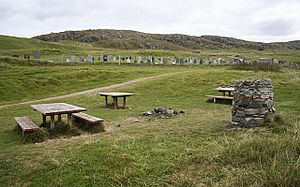Dail Mòr facts for kids
 |
|
| Alternative name | Dalmore |
|---|---|
| Location | Isle of Lewis |
| Region | Scotland |
| Coordinates | 58°18′10″N 6°45′00″W / 58.302778°N 6.75°W |
| Type | Beach |
| History | |
| Founded | Bronze Age |
| Site notes | |
| Excavation dates | 1982 |
| Archaeologists | Gerald Ponting, Margaret Ponting |
| Public access | Yes |
Dail Mòr (also known as Dalmore) is a small village, called a hamlet, located on the Isle of Lewis in Scotland. It is part of the Carloway area. This peaceful place is known for its beautiful beach and a historic cemetery. Visitors can use a car park, picnic areas, and public BBQ facilities.
The beach at Dail Mòr is a popular spot for surfing. Many guidebooks mention it as a great place to catch waves. However, it's important to know that there is a strong rip current at the north end of the beach. A rip current is a powerful, narrow channel of water moving quickly away from the shore.
Even though Dail Mòr is in a remote area, most of its houses were connected to fibre broadband in November 2012. This means they had very fast internet access.
In August 2016, a large oil rig named Transocean Winner ran aground near Dalmore beach. The rig was being pulled by a tug boat from Norway to Malta when it broke free.
Contents
Exploring Ancient Dail Mòr
Dail Mòr is not just a pretty beach; it's also a place with a long history. People have found many clues about ancient life here.
Discovering Old Structures
In 1982, archaeologists Gerald and Margaret Ponting started digging at Dail Mòr. This happened after part of the sea wall near the beach collapsed. Later, other experts, Sharples and Curtis, continued the work.
They found stone structures from prehistoric times. These were likely homes where people lived long, long ago. They also found many objects, called artefacts, left behind by ancient cultures.
Artefacts and Tools from the Past
Some of the oldest finds were from the Neolithic period, which was a time when people first started farming. More recent finds were from the Beaker culture, a group of people who lived in the Bronze Age.
The archaeologists found tools made from bone and antler. They also discovered pieces of pottery, which are old clay pots. A lot of flint pieces and arrowheads were found during the digs and on the beach. This suggests that the area might have been a workshop where people made tools and weapons.
One special object found was the "Dalmore bone." It's a small, square-shaped bone, about 34mm long, with a hole in it. It also has zig-zag markings. Experts P.J. Scott and Margaret Ponting studied these markings to understand what they meant.
Images for kids





